I just ordered some neolube to test out. Hopefully I can get a good batch of reloads made up in the next few weeks. It takes time sorting the marking and recording all the load details and then tabulating the data.Thanks for your responses. I'm probably one of many waiting to see if and what significant correlations result from your efforts.
I did not know of Neolube (apparently graphite particles) but have found coating of the inside of necks with moly powder can be best done with a suspension of moly powder in GunScubber, and with lanolin in a solution of lanolin in xylene solvent. Both can be applied with a Q-tip, and the carrier volatilizes off quickly. (Lanolin is not soluble in isopropanol as reported in other forums.) I'd be interested the effect of either of these on seating force, MV and precision. I have pretty much universally, in multiple cartridges, found the best precision with bullets seated with the minimum neck hold required to keep the bullet in place when twisted by hand.
You are using an out of date browser. It may not display this or other websites correctly.
You should upgrade or use an alternative browser.
You should upgrade or use an alternative browser.
DIY Hydro Seating Press - Another Reloading Rabbit Hole
- Thread starter ToolAA
- Start date
The #1 community for Gun Owners of the Northeast
Member Benefits:
No ad networks! Discuss all aspects of firearm ownership Discuss anti-gun legislation Buy, sell, and trade in the classified section Chat with Local gun shops, ranges, trainers & other businesses Discover free outdoor shooting areas View up to date on firearm-related events Share photos & video with other members ...and so much more!
Member Benefits:
I guess I still have a budget, but sort of like the Fed, I often exceed it.I don’t know where I’ve been lurking, but it should have been here. I work in aerospace, and I can appreciate the work you’ve done on this project.
It’s checked a lot of the same technical areas of a space project: mechanical, software, controls, metrology. Range time is akin to environmental test or flight test. Cool. You’re just missing budgets and program management, but it’s a hobby so you get to ignore those.
Brings back painful career memories. Back in the early 2000's at my previous career, we were developing some really tight tolerance polymer fiber optic components. The concentricity of the fiber guide had to be less than 1um within a 2.5mm LCP ferrule. Even with the most precision molds, we could build, the variations in injection pressures were causing 20% rejects. The only way we could successfully injection mold the parts was using a $180K Arburg closed loop injection molding machine. We had a custom interface added which would connect to two pressure sensors within the mold. Those two sensors, along with the ones within the machine itself, would throttle the speed of the injection in order to achieve a very consistent flow. Even with all of that investment, we still had 10% rejects.Let me know if you ever want any help on the Arduino coding, but it looks like you’re done. I was wondering if a pressure feedback control from the hydraulic sensor to the motor control, e.g. maybe as simple as a proportional controller, could produce more consistent force application during bullet seating.
I’m pondering whether force is a function of the depth the bullet has been seated to or force is a function of time. The graphs of seating force vs time look like the pressure profiles are pretty consistent even if the peak pressures vary, so maybe nothing to be gained from a feedback control.
Anyway, kudos to you. Cool project.
I think in this specific application the speed at which the projectile is inserted, could cause the max pressure to increase. However, if the speed is fairly constant, I suspect the changes in setting force are always proportional to the amount of interference between the case neck and the projectile in addition to the neck length. It seems like the there is a drop in pressure once the base of the projectile clears the bottom of the neck.
There IS a drop in seating force once the bullet shank clears the neck because the bullet is slightly expanding the neck. Once you have made the whole neck "bullet diameter ID" you have less resistance.I guess I still have a budget, but sort of like the Fed, I often exceed it.
Brings back painful career memories. Back in the early 2000's at my previous career, we were developing some really tight tolerance polymer fiber optic components. The concentricity of the fiber guide had to be less than 1um within a 2.5mm LCP ferrule. Even with the most precision molds, we could build, the variations in injection pressures were causing 20% rejects. The only way we could successfully injection mold the parts was using a $180K Arburg closed loop injection molding machine. We had a custom interface added which would connect to two pressure sensors within the mold. Those two sensors, along with the ones within the machine itself, would throttle the speed of the injection in order to achieve a very consistent flow. Even with all of that investment, we still had 10% rejects.
I think in this specific application the speed at which the projectile is inserted, could cause the max pressure to increase. However, if the speed is fairly constant, I suspect the changes in setting force are always proportional to the amount of interference between the case neck and the projectile in addition to the neck length. It seems like the there is a drop in pressure once the base of the projectile clears the bottom of the neck.
I haven’t had much time to put into reloading but I prepared a batch of 20 tonight with the most amount of data collected thus far. My goal is to chrono these 20 tomorrow and then using the that info, prepare another 50-60 for an upcoming PNTC visit. Hopefully my work schedule this week cooperates.
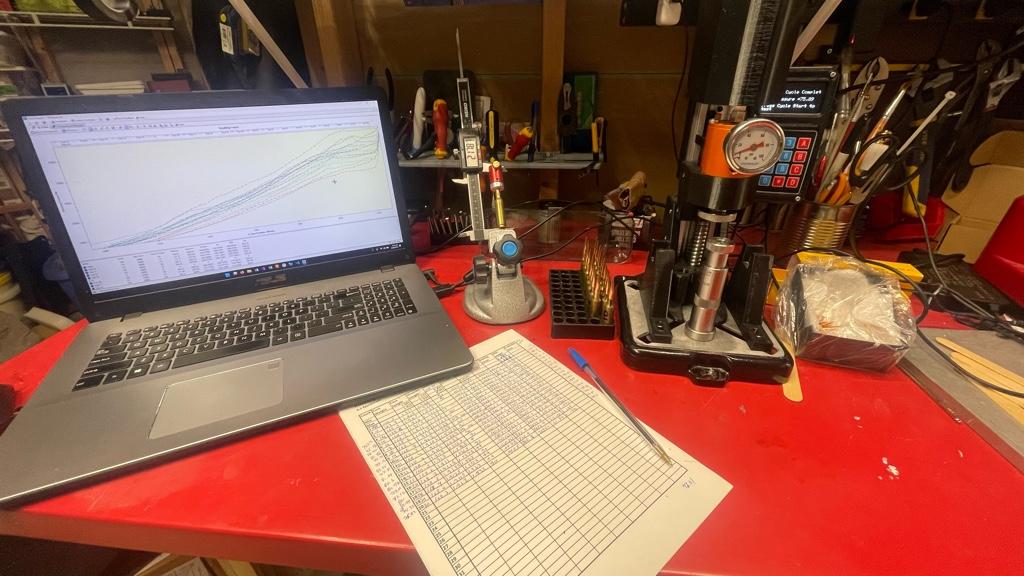
Sent from my iPhone using Tapatalk

Sent from my iPhone using Tapatalk
Figured I would report back here with the results of Sunday’s PNTC range trip. To recap, I was trying to see if projectile seating force correlates to projectile velocity with all other variables being controlled as tightly as possible. Short answer is that it does not appear to be the case. However, the data collected is interesting none the less.
Let me first explain what information was collected during reloading and recorded in the tables below.
Projectiles were Weighed and Sorted and the I selected only those within about 0.5 gr if each other for these tests. Weight was recorded for each load.
Cases were Weighed and Sorted and the I selected only those within about 0.5 gr if each other for these tests. Weight was recorded for each load.
Case length from head to case mouth was sized and measured within 0.0035”
Shoulder length sized and measured within 0.0025”
Case neck O.D. were measured using sizing dies as a GO/NG gauges and all cases were between 0.290” - 0.291” and fit without considerable force.
Neck Concentricity was measured to be 0.0015” or less.
Each case mouth ID was checked with GO 0.2605”+ and NG 0.2615- gauges.
Projectile seating force was recorded using the press and graphed.
Seating depth was set using my Wilson die then measured to be less than 0.002”
Projectile runout measured from the Ogive was measured and when large runout was detected, the projectile position was adjusted by hand to less than 0.003”
Virgin Alpha Brass loading data
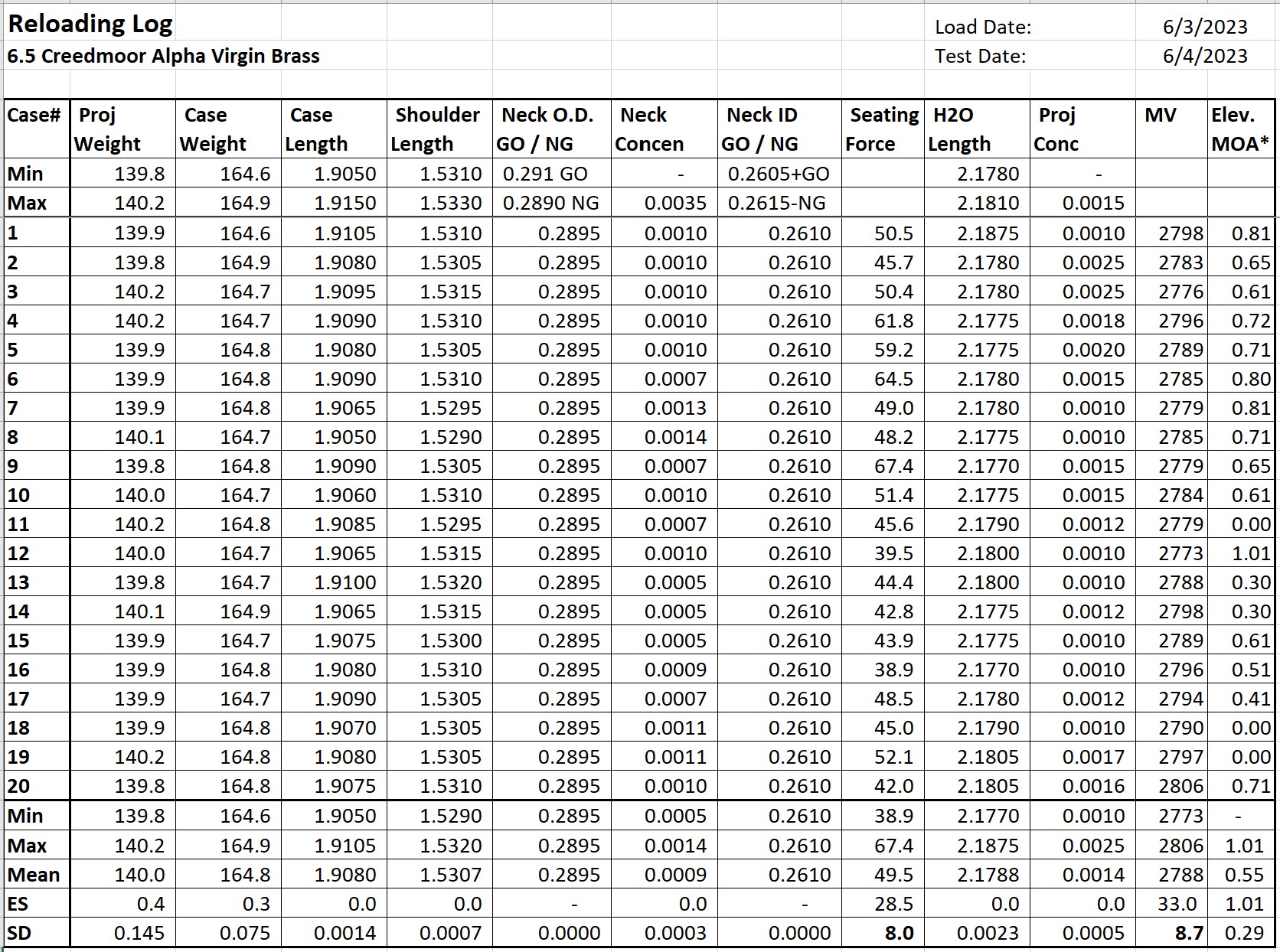
Virgin Alpha Brass Seating Force Graph
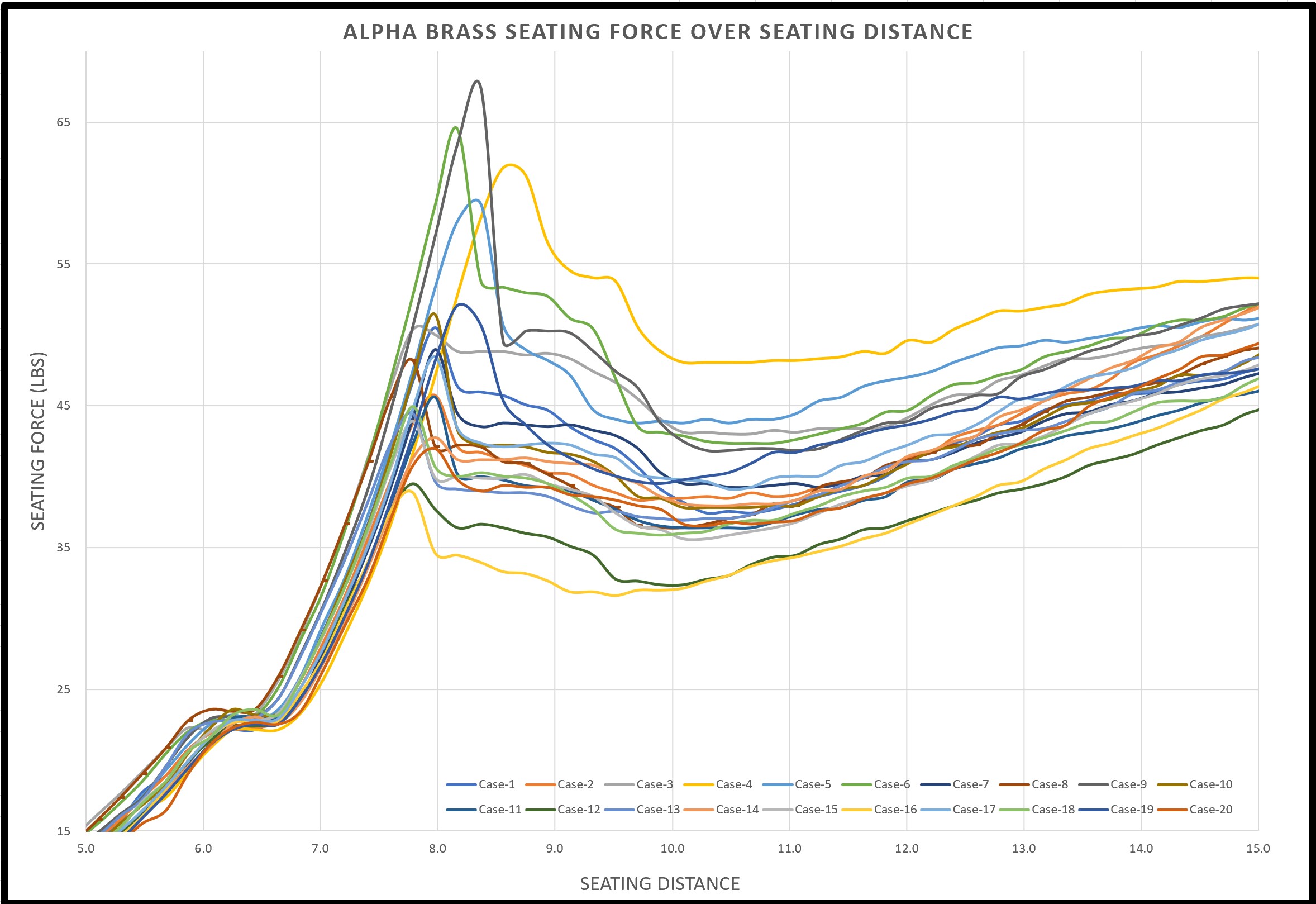
Virgin Lapua Brass Loading Data
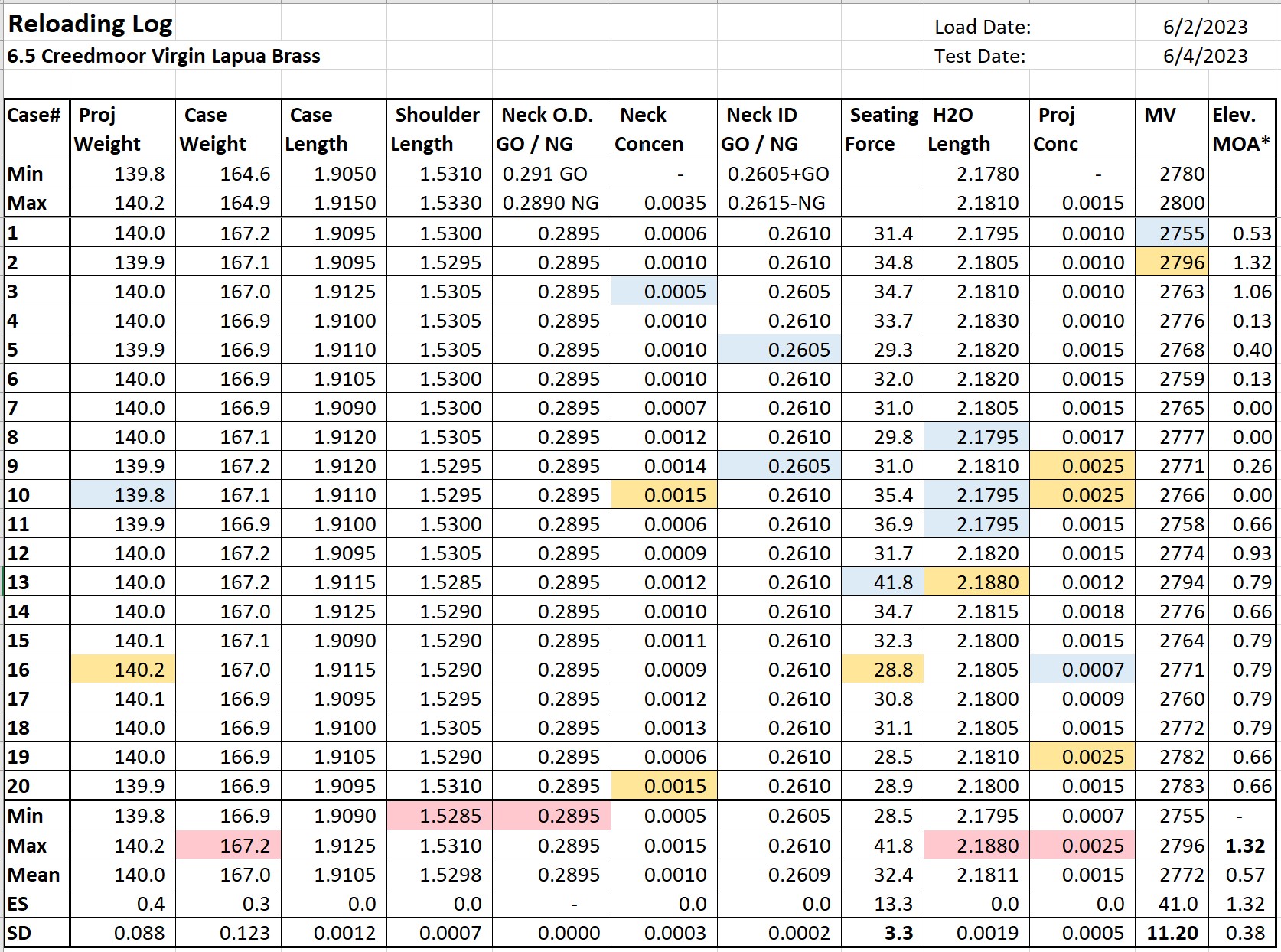
Virgin Lapua Brass Seating Force Graph
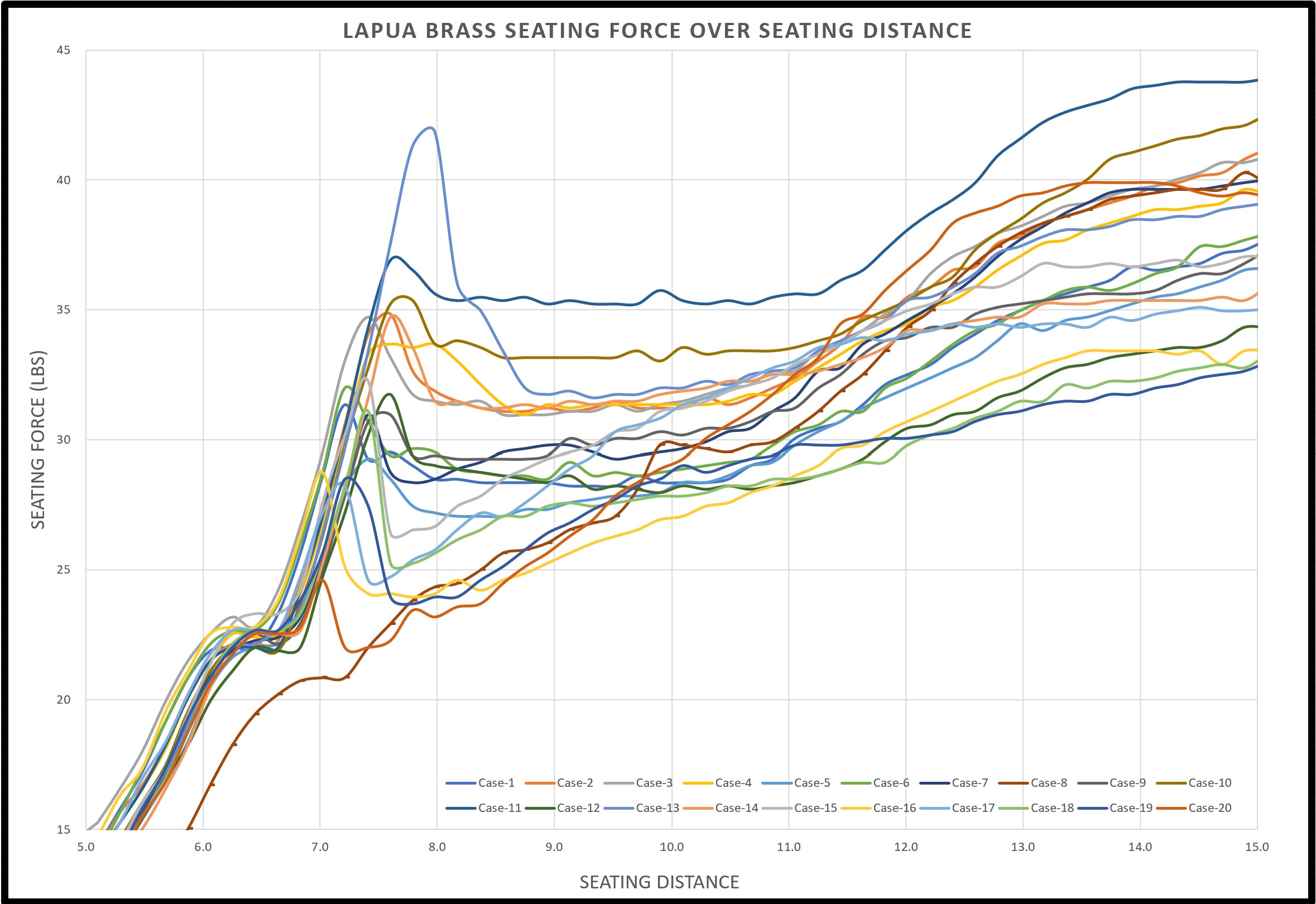
Lapua Brass Reloaded 4 Times Data
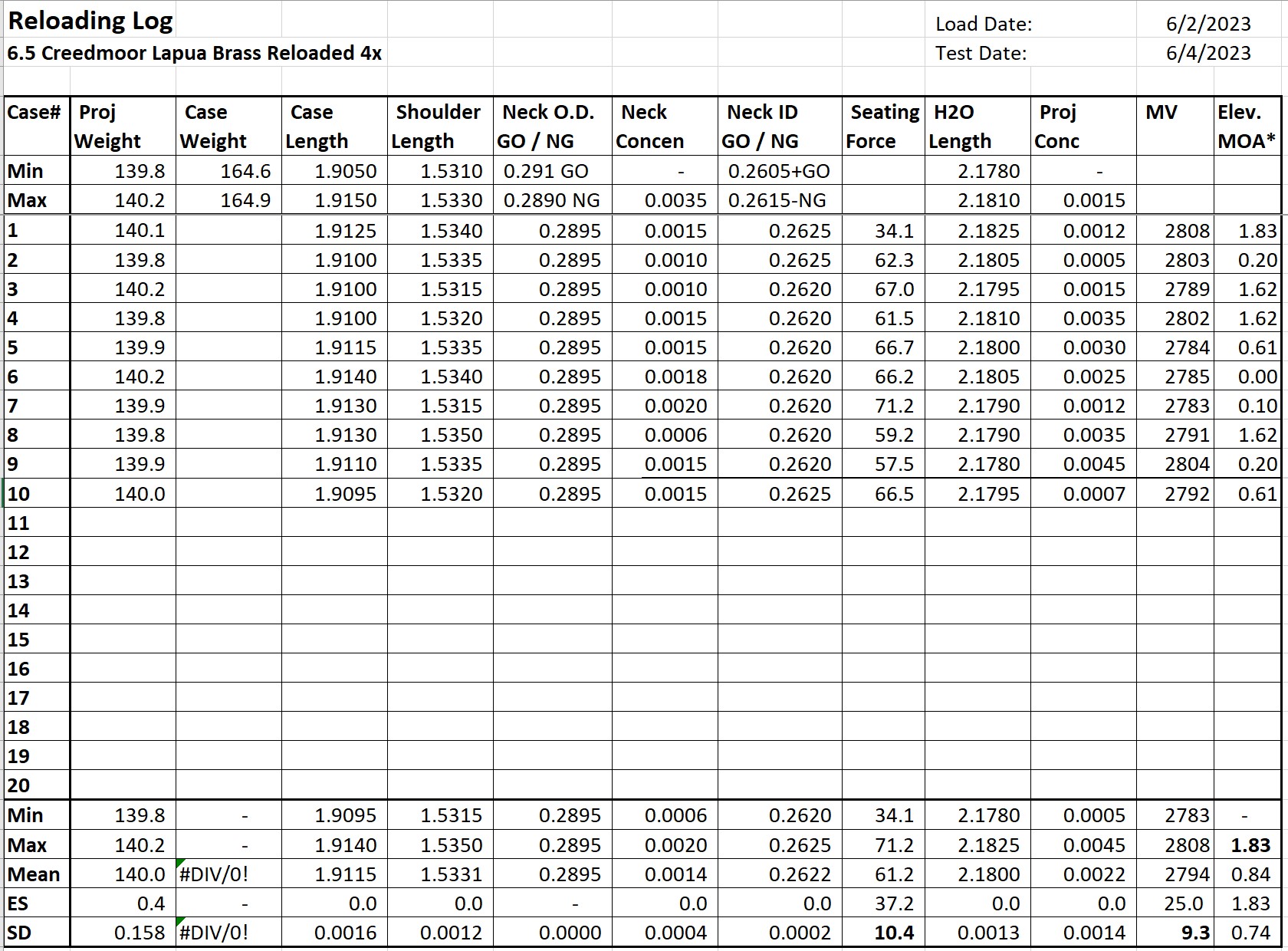
Lapua Brass Reloaded 4 Times Seating Force Graph
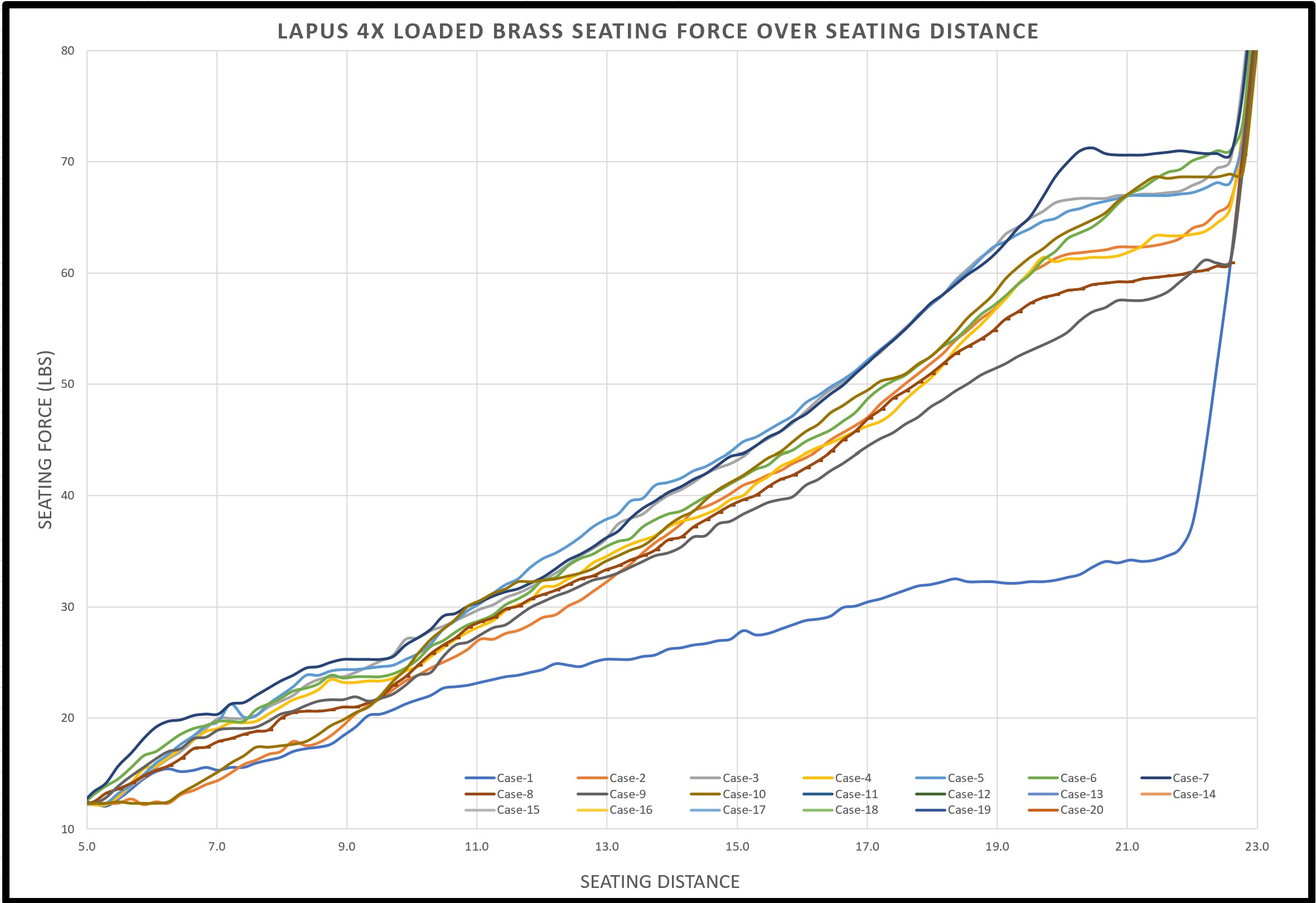
At the range conditions were perfect. Winds were less than 3mph with no gusts. Shots were taken from prone position on bipod.
Target for the Alpha and Lapua vergin brass were an 18” plate at 650 yards. The 4x loaded brass was shot on a 12” plate at 560 yards.
Time was taken for each shot was mostly between 1-3 min and the barrel was allowed to cool after each 5 round string. Squaregrouper was spotting and recording shot data.
Muzzle Velocity was recorded with lab radar at the range and noted along with the relative impact position on steel. This was done by charting the impact locations while firing and determining the MOA based on the target distance and plate size.
I’ve got to get up early tomorrow for a business trip to Grand Rapids so I’ll sign off for now and update this post with my conclusion and observations tomorrow probably from the airport.
Interested to hear what everyone has to say.
Sent from my iPhone using Tapatalk
Let me first explain what information was collected during reloading and recorded in the tables below.
Projectiles were Weighed and Sorted and the I selected only those within about 0.5 gr if each other for these tests. Weight was recorded for each load.
Cases were Weighed and Sorted and the I selected only those within about 0.5 gr if each other for these tests. Weight was recorded for each load.
Case length from head to case mouth was sized and measured within 0.0035”
Shoulder length sized and measured within 0.0025”
Case neck O.D. were measured using sizing dies as a GO/NG gauges and all cases were between 0.290” - 0.291” and fit without considerable force.
Neck Concentricity was measured to be 0.0015” or less.
Each case mouth ID was checked with GO 0.2605”+ and NG 0.2615- gauges.
Projectile seating force was recorded using the press and graphed.
Seating depth was set using my Wilson die then measured to be less than 0.002”
Projectile runout measured from the Ogive was measured and when large runout was detected, the projectile position was adjusted by hand to less than 0.003”
Virgin Alpha Brass loading data

Virgin Alpha Brass Seating Force Graph

Virgin Lapua Brass Loading Data

Virgin Lapua Brass Seating Force Graph

Lapua Brass Reloaded 4 Times Data

Lapua Brass Reloaded 4 Times Seating Force Graph

At the range conditions were perfect. Winds were less than 3mph with no gusts. Shots were taken from prone position on bipod.
Target for the Alpha and Lapua vergin brass were an 18” plate at 650 yards. The 4x loaded brass was shot on a 12” plate at 560 yards.
Time was taken for each shot was mostly between 1-3 min and the barrel was allowed to cool after each 5 round string. Squaregrouper was spotting and recording shot data.
Muzzle Velocity was recorded with lab radar at the range and noted along with the relative impact position on steel. This was done by charting the impact locations while firing and determining the MOA based on the target distance and plate size.
I’ve got to get up early tomorrow for a business trip to Grand Rapids so I’ll sign off for now and update this post with my conclusion and observations tomorrow probably from the airport.
Interested to hear what everyone has to say.
Sent from my iPhone using Tapatalk
Looks like a lot of data.
Did you measure and record case head diameters.
And, what were the differences that you noted between any new ,once fired or 4x fired cases.
Did you measure and record case head diameters.
And, what were the differences that you noted between any new ,once fired or 4x fired cases.
KRC
Active Member
Although expected(?), quite a difference between virgin and 4X brass. Did you anneal between these 4X loadings? (You have previously mentioned annealing.)
Interested in "the rest of the story".
Interested in "the rest of the story".
Looks like a lot of data.
Did you measure and record case head diameters.
And, what were the differences that you noted between any new ,once fired or 4x fired cases.
No I did not measure the case head diameter. I didn’t think it was a critical parameter.
Since I tested Alpha Virgin Brass, Lapua Virgin Brass and Virgin Brass loaded 4 times, probably the most meaningful comparison would be between the Lapua
Virgin and Lapua 4x. Here are the real differences that I noticed (4x vs Virgin):
Case Length
1.9115” +/- .001”
vs
1.9105” +/- .0017”
Shoulder a length
1.5331” +/- .0017”
Vs
1.5228” +/- .0012”
Neck Concentricity
<0.002”
Vs
<0.0015”
Seating Depth
2.1800” +/- .0020”
Vs
2.1811” +/- .0007”
Projectile Runout
<0.004”
Vs
<0.0025”
All other controlled parameters were basically the same between virgin and reloaded.
However seating force the largest and only significant difference that I detected.
The 4x loaded brass required significantly greater seating force, and the profile of the force graph as also significantly different. At first glance the overall force average was about 61lbs for 4x vs 32 for Virgin. If you look closely at the two graphs you’ll also notice for the Virgin brass, the seating forces climbs rapidly at first as the projectile is seated, then drops off sharply as the rear of the projectile passes through the bottom of the next. That makes total sense as the neck is slightly stretched as the projectile moves down, and the force of the neck increases as the surface area of contact increases. Once the tail passes the bottom, the force drops sharply as the neck is now slightly stretched.
Now look at the 4x loaded brass. The force increase’s basically linearly the entire way. There is no dropoff around 10mm when the projectile passes the bottom of the next. Instead you see more of a plateau around 20mm which is just before the die reaches contact with the ram.
So what does that mean? The only thing I can conclude is that the cases were annealed after the 3rd firing, but I must not have annealed them enough or properly. The metal is still too hard, and is not stretching as much.
The consistency for both loads in terms of seating force was actually pretty good. Look at the 4x loaded chart, and you’ll see that the StdSev of the seating force was 10.4 vs 3.3 for the virgin brass. That was surprisingly consistent.
Now here is where my hypothesis seems to be wrong. My theory was that increased force required to seat, caused more neck tension, which would increase the muzzle velocity slightly. The results for 4x loads was 2794 fps with 9.3 SD vs 2794 fps with 11.2 SD
How all of this impact the accuracy and consistency of the fired rounds also are not obvious.
The 4x loaded brass was 1.83 MOA at 560yds over 10 rounds vs 1.32 MOA at 650 yds over 20 rounds. Squargrouper was spotting and charting those shots and there was a good string of maybe 6-7 shots that were within a 2” group dead center of the gong at 650yds.
Sent from my iPhone using Tapatalk
Last edited:
Although expected(?), quite a difference between virgin and 4X brass. Did you anneal between these 4X loadings? (You have previously mentioned annealing.)
Interested in "the rest of the story".
See my post to Doco above. I did anneal the 4x brass after the 3rd firing. I built an annealer a few years ago and I used templaque paint to dial in the heat, but it sure seams like those cases are NOT annealed correctly or enough.
What I think I’m going to do is build a test jig with a 0.262” gauge pin and attach it to the seating press. Then I can actually anneal a bunch of cases at different temps and times and simply measure the difference and consistency of press force. This wouldn’t require making live rounds.
That would obviously be a detour in the rabbit hole for sure.
Sent from my iPhone using Tapatalk
Squaregrouper
Kragaphile
I drew circles with numbers on a piece of paper for ToolAA. So I got that going for me, which is nice.
I drew circles with numbers on a piece of paper for ToolAA. So I got that going for me, which is nice.
Actually It’s way more fun going together or with a group IMO. I have to say I was having some trouble spotting some of your early Grendel rounds.
Sent from my iPhone using Tapatalk
The methods and notes are so methodical when I looked at them I thought why not take the extra step.Although expected(?), quite a difference between virgin and 4X brass. Did you anneal between these 4X loadings? (You have previously mentioned annealing.)
Interested in "the rest of the story".
Annealing cartridge cases at the neck is one thing but they are also subject to increased hardening the closer you get to the web, through the body area, and then to the head of the case.
They're manufactured like that. And differing lots exhibit differing characteristics.
Because some of your measurements are to the x thou, I thought why not determine any difference in head expansion between all the cases you inspected and recorded data for.
The head of the case has an effect on pressure characteristics that maybe you may be able to link some the other data already collected to determine a specific characteristic that could be helpful.
Make some sort of discovery or something based on the efforts in addition to what's already being examined.
Somewhere I have text which describes the annealing process during cartridge manufacture thats very interesting with data obtained from the laboratory results garnered through experimentation and known metallurgical qualities of the materials and processes used during production.
I would have expected the similar seating pressure would have grouped similar. That's assuming that seating pressure correlates to neck tension/consistent release as it does in my brain lol.
Although your average fps seems the same (if I'm reading it correctly) your SD is larger on virgin brass. Id imagine your ES was larger if you shot the same about of rounds also. If that is true you would have a more consistent flight path/ POI with consistent seating pressures, 4x times brass in this case .
I'm 1/2 asleep and might have read everything incorrectly, if so just ignore.
Although your average fps seems the same (if I'm reading it correctly) your SD is larger on virgin brass. Id imagine your ES was larger if you shot the same about of rounds also. If that is true you would have a more consistent flight path/ POI with consistent seating pressures, 4x times brass in this case .
I'm 1/2 asleep and might have read everything incorrectly, if so just ignore.
I would have expected the similar seating pressure would have grouped similar. That's assuming that seating pressure correlates to neck tension/consistent release as it does in my brain lol.
Although your average fps seems the same (if I'm reading it correctly) your SD is larger on virgin brass. Id imagine your ES was larger if you shot the same about of rounds also. If that is true you would have a more consistent flight path/ POI with consistent seating pressures, 4x times brass in this case .
I'm 1/2 asleep and might have read everything incorrectly, if so just ignore.
I’m boarding a flight back to BWI now so we can surely discuss tomorrow. I think the reason that the ES was lower on the 4x brass was because the sample size was only 10 rounds vs 20 rounds of virgin brass.
I did try to run a correlation function on seating force vs muzzle velocity and the value was less than .25 which is not a strong correlation. I many need to conduct some special test loads where I intentionally underside the case next and compare those results with the virgin brass.
Sent from my iPhone using Tapatalk
Cool project. I'm curious as to why you chose a hydraulic system w/ leaking, stiction, etc over an electronic load cell? Especially since you seem handy at the electronic/programming side.
I was getting problems with stiction of the cylinder. I took your advice and picked up a cheap load cell. The other reason was that this specific load cell measure pressure and tension. So I had the crazy idea to test neck tension using just a straight .261 gauge pin, chamfered at the bottom to match my typical nosler RDF bullet.
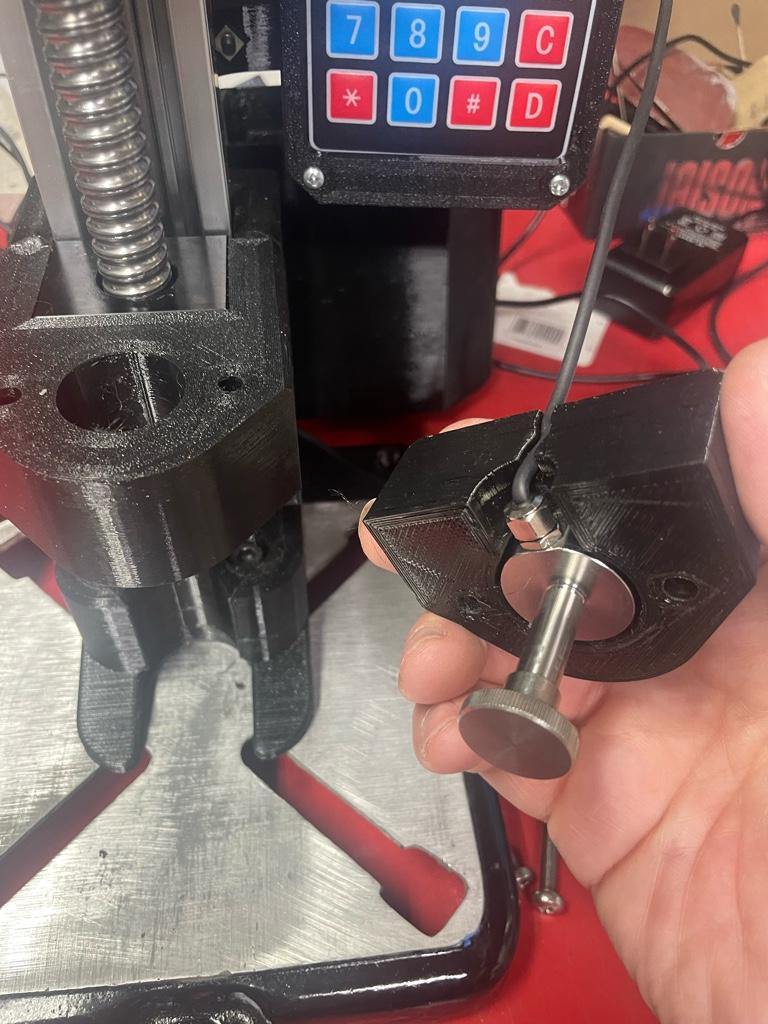
I’ll size the case, use the press to push the pin into the neck to chart the result, then also chart the force needed to remove the pin. This way I can quickly compare different neck sizing dimensions and annealing parameters before loading up 20 rounds and sending them down range.
Sent from my iPhone using Tapatalk
There IS a drop in seating force once the bullet shank clears the neck because the bullet is slightly expanding the neck. Once you have made the whole neck "bullet diameter ID" you have less resistance.
Thought you might be interested in this next round of neck tension testing. It’s not so much that I have useful data yet, but I’m curious as to what you think of the test method.
I upgraded my seating press with a small force sensor that is more accurate than the previous piston pressure sensor. Also this sensor can measure force in both directions.
I picked up a gauge pin that is the same size as my Nosler 6.5mm projectiles. I ground the tail to be similar geometry to the projectile as well. I mounted the pin in an adaptor and attached it to the force sensor.
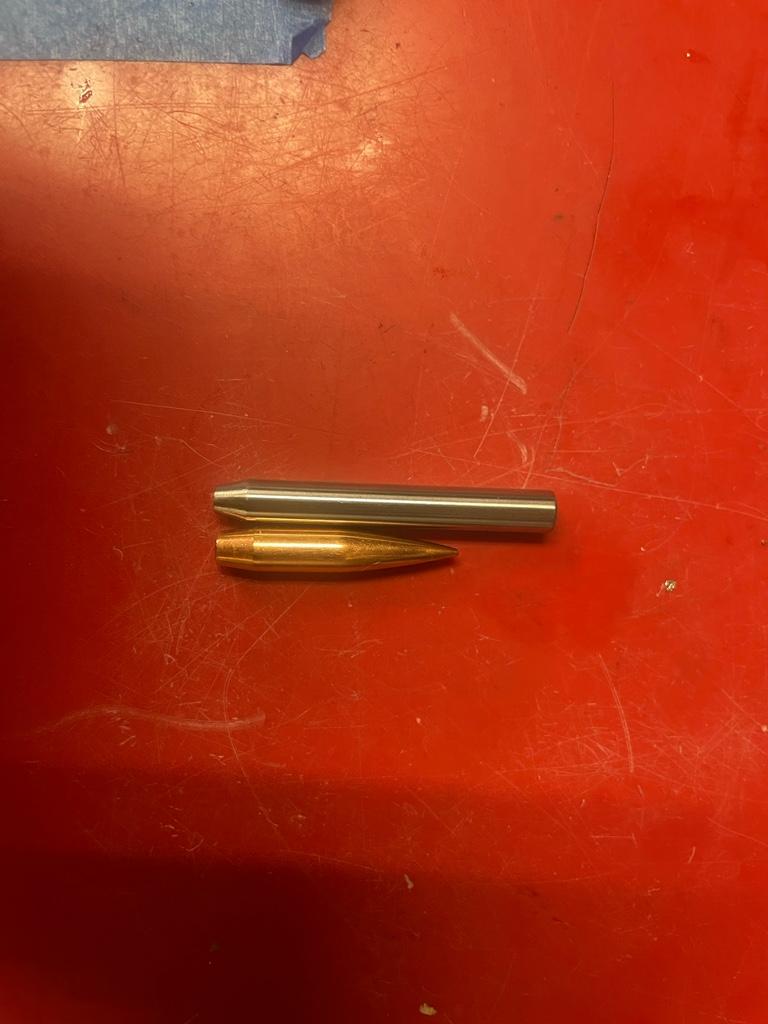
Then added a shell plate to the bottom of the press. After making some changes to my code, I can now measure pressure on the downward stroke as well as (neck tension) on the return stroke.
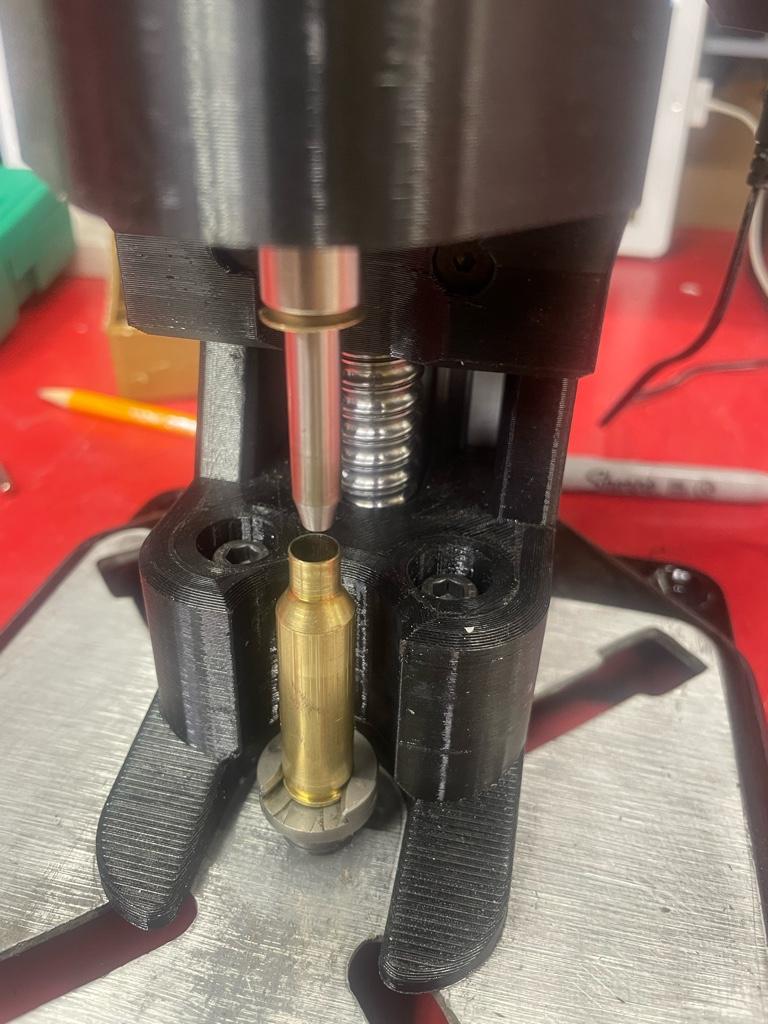
The concept is that with the hardened pin and the better sensor, I should be able to quickly compare different sizing, prep, annealing and lubricant factors on seating force and neck tension. Since the pin is the same, I can rule out some differences between individual projectiles. This would allow me to conduct a lot of test quickly, without burning through reloading components.
I just conducted two quick tests to see if the concept works as intended.
First test was done using 10 previously reloaded Lapua cases. They were all quickly sized using a full length die. 0.290 neck bushing, and a simple nylon brush to clean the inside of the neck. The variation was actually surprisingly wide. The chart below shows only the two most extreme plots. If you look at the plot lines you’ll see a small vertical line at around 3150 on the X axis. That’s the point that the press stops it’s downstroke. Everything to the right of that point is measuring the load on the return stroke. The sharp drop in force just to the left is where the tail of the ram probe, passes through the next into the case body.
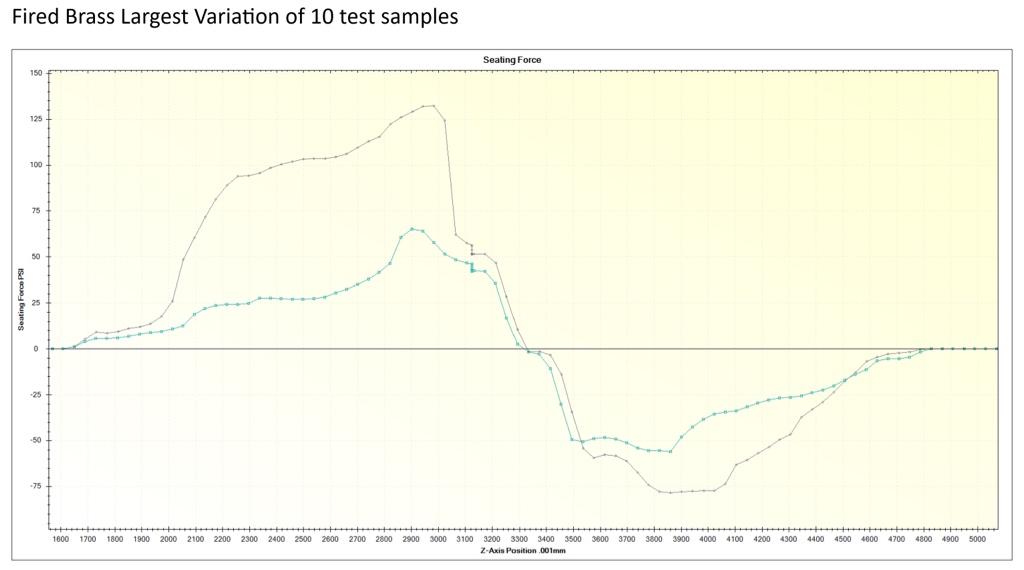
The next test was done using 10 virgin Lapua cases. Right out of the box. No cleaning, turning or sizing. Except for one outlining case, the other 9 cases still have about a 20% force spread at max and 50% tension spread on the return stroke.
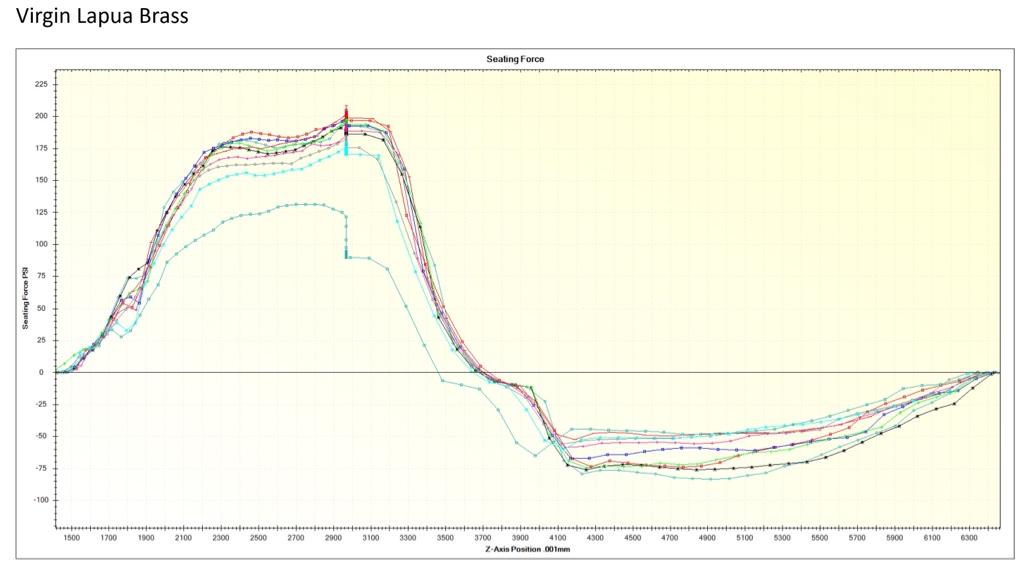
I do realize a mistake in the charts. The laptop software still has the conversion factor for the PSI function setup for the old piston sensor. The scale of that axis should be about 1/2 of what is shown.
Sent from my iPhone using Tapatalk
First glance, much better test method. I'm not an engineer, just a dumbass rifle junkie.Thought you might be interested in this next round of neck tension testing. It’s not so much that I have useful data yet, but I’m curious as to what you think of the test method.
I upgraded my seating press with a small force sensor that is more accurate than the previous piston pressure sensor. Also this sensor can measure force in both directions.
I picked up a gauge pin that is the same size as my Nosler 6.5mm projectiles. I ground the tail to be similar geometry to the projectile as well. I mounted the pin in an adaptor and attached it to the force sensor.

Then added a shell plate to the bottom of the press. After making some changes to my code, I can now measure pressure on the downward stroke as well as (neck tension) on the return stroke.

The concept is that with the hardened pin and the better sensor, I should be able to quickly compare different sizing, prep, annealing and lubricant factors on seating force and neck tension. Since the pin is the same, I can rule out some differences between individual projectiles. This would allow me to conduct a lot of test quickly, without burning through reloading components.
I just conducted two quick tests to see if the concept works as intended.
First test was done using 10 previously reloaded Lapua cases. They were all quickly sized using a full length die. 0.290 neck bushing, and a simple nylon brush to clean the inside of the neck. The variation was actually surprisingly wide. The chart below shows only the two most extreme plots. If you look at the plot lines you’ll see a small vertical line at around 3150 on the X axis. That’s the point that the press stops it’s downstroke. Everything to the right of that point is measuring the load on the return stroke. The sharp drop in force just to the left is where the tail of the ram probe, passes through the next into the case body.

The next test was done using 10 virgin Lapua cases. Right out of the box. No cleaning, turning or sizing. Except for one outlining case, the other 9 cases still have about a 20% force spread at max and 50% tension spread on the return stroke.

I do realize a mistake in the charts. The laptop software still has the conversion factor for the PSI function setup for the old piston sensor. The scale of that axis should be about 1/2 of what is shown.
Sent from my iPhone using Tapatalk
Using the pin is a good empirical test. As you say it eliminates bullet variance and jacket quality/consistency as variables. One place this may cause a slight issue in applying the data from the pin to actual bullets as a predictive model is the tendency of the brass to have a slight burr after trim/chamfer/debur. The pin, like a mandel, will just push it out of the way but it may result in more variance with an actual bullet being seated.
I don't shoot a creedmoor but I am tooled to process it (a couple of coworkers pay me to prep their brass). I can do some up and send em to you/meet up if you want comparative samples.
First glance, much better test method. I'm not an engineer, just a dumbass rifle junkie.
Using the pin is a good empirical test. As you say it eliminates bullet variance and jacket quality/consistency as variables. One place this may cause a slight issue in applying the data from the pin to actual bullets as a predictive model is the tendency of the brass to have a slight burr after trim/chamfer/debur. The pin, like a mandel, will just push it out of the way but it may result in more variance with an actual bullet being seated.
I don't shoot a creedmoor but I am tooled to process it (a couple of coworkers pay me to prep their brass). I can do some up and send em to you/meet up if you want comparative samples.
I’ll take you up on that offer next time we are at PNTC.
After I properly calibrated the load sensor, I decided to actually so a quick comparison before bed.
First chart is again Virgin Lapua brass, but this time I ran it through my 0.261 expander mandril die, and did a quick 0.2615- GO and 0.2615+ NG check. This way I could make sure that each case was similar. The results were about the same as the previous batch checked. Again, one oddball case and the other 9 varied between 100lbs and 125lbs of seating force.
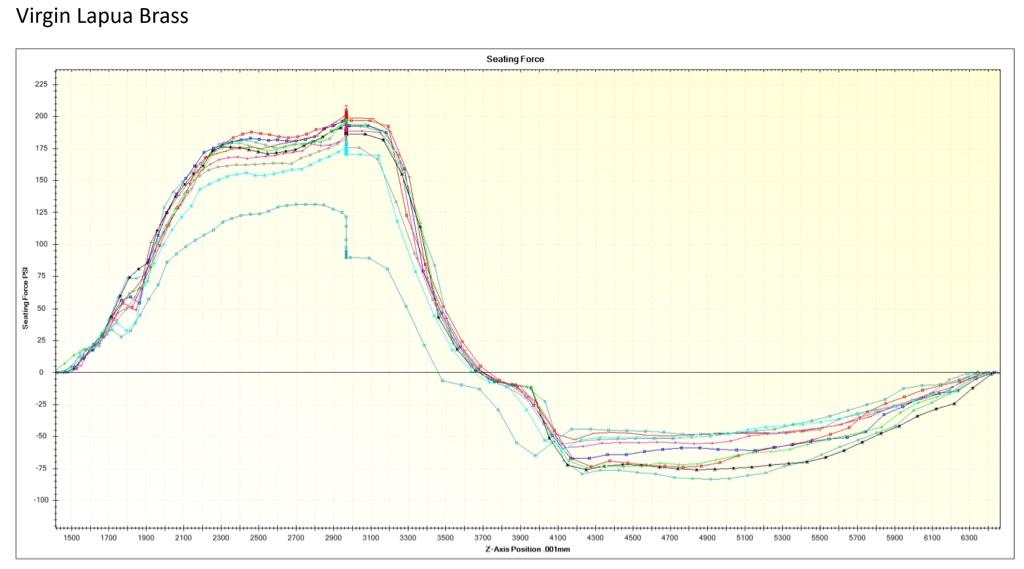
Next I did the exact same prep and check with 10 more cases. However this time, I wiped the inside of the neck with a thin film of NeoLube. There is a noticeable drop in force the about 60% lower ranging from 46lbs to 52lbs. Also there was considerably less variation between the force plots as well. The release tension was an even tighter plot.
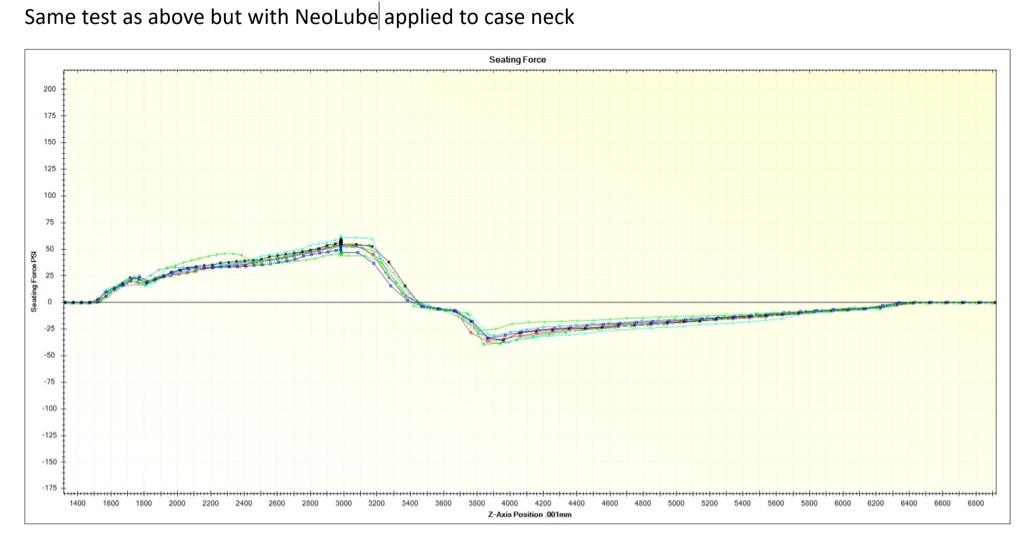
Sent from my iPhone using Tapatalk
You definitely have cooler toys than I do.I’ll take you up on that offer next time we are at PNTC.
After I properly calibrated the load sensor, I decided to actually so a quick comparison before bed.
First chart is again Virgin Lapua brass, but this time I ran it through my 0.261 expander mandril die, and did a quick 0.2615- GO and 0.2615+ NG check. This way I could make sure that each case was similar. The results were about the same as the previous batch checked. Again, one oddball case and the other 9 varied between 100lbs and 125lbs of seating force.

Next I did the exact same prep and check with 10 more cases. However this time, I wiped the inside of the neck with a thin film of NeoLube. There is a noticeable drop in force the about 60% lower ranging from 46lbs to 52lbs. Also there was considerably less variation between the force plots as well. The release tension was an even tighter plot.

Sent from my iPhone using Tapatalk
Out of curiosity what are you using for case neck lube? I’ve recently started using neolube and have seen some benefit on target.
Meant to quote you yesterday when I posted a direct comparison of seating force with and without Neolube. Check out the post #56 and #58 above.
Sent from my iPhone using Tapatalk
Users who are viewing this thread
Total: 2 (members: 0, guests: 2)

